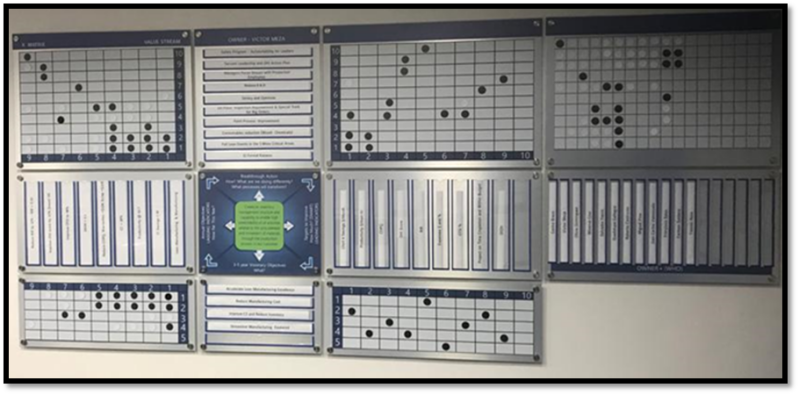
Hoshin Kanri
The hoshin kanri methodology employs a structured planning and deployment cycle during which goals are determined, plans to achieve the goals are established, and measures are created to ensure progress toward these goals. Hoshin Kanri is a process that organizations use to develop their long-term strategy into concrete plans, and then execute that strategy over time.
This planning process is designed to ensure that the mission, vision, goals, and annual objectives are communicated throughout an organization, and implemented by everyone from top management to the shop floor level. Then goals and work plans are developed, based on the collectively chosen vision statement; and progress towards them is periodically monitored through performance audits.
Hoshin Kanri is a Japanese phrase and word meaning is given below:
Hoshin = Shining needle pointing direction, as in compass
Kanri = Control or Management
Values, Mission, and Vision
The first step of creating a strategy is to understand where we are and where we want to be in the future. That involves creating a Mission, Values and a Vision.
The mission of a company is a statement that defines its purpose and the reason for its existence. It is a clear and concise declaration that outlines the company's goals, values, and objectives. The mission statement guides the company's decision-making process and helps to align its actions with its vision for the future. A well-crafted mission statement can inspire and motivate employees, attract customers, and differentiate the company from its competitors. It also serves as a benchmark for evaluating the company's performance and progress towards achieving its goals. Overall, the mission statement is a vital component of any successful company's strategy.
The values of a company are the principles and beliefs that guide its actions and decisions. They are often expressed in the company's mission statement or code of conduct and are expected to be upheld by all employees. Values can vary depending on the industry, culture, and goals of the company, but some common examples include honesty, integrity, diversity, teamwork, innovation, and customer satisfaction. By having strong values, a company can create a positive reputation, attract top talent, and build strong relationships with customers and stakeholders.
The company’s vision is a statement that outlines its long-term aspirations and goals. It serves as a guide for decision-making and helps to align the efforts of employees towards a common objective. A compelling vision should be inspiring, clear, and concise. It should communicate the company's purpose, values, and direction. A well-defined vision can motivate employees, attract customers, and drive innovation. It is important for a company to periodically review and update its vision to ensure it remains relevant and achievable.
SWOT analysis
SWOT is an acronym that stands for Strengths, Weaknesses, Opportunities, and Threats. It is a framework commonly used in business to assess the current state of a company or organization. By analyzing these four factors, businesses can identify areas of improvement, determine potential risks, and develop strategies for growth. It is important to conduct a SWOT analysis regularly to stay competitive and adapt to changes in the market.

A method utilized to determine threats to the business is the PESTLE method:
Political factors that may affect the current or future of the business.
Economic factors such as market fluctuations or taxes.
Social Factors such as lifestyles, trends, and media.
Technological factors present changes with significant impact.
Legal factors as laws and regulations.
Environmental Factors both local and global.

X-Matrix
The X-Matrix is one of the more powerful visualization tools in Hoshin Kanri, the goal of applying the X matrix is to align the long-term needs with strategic initiatives, identify the most important activities along the way, and list the metrics that you need to improve.

- Long Term Goals (Breakthrough Objectives)
- Step number one is to set long term, visionary goals, or objectives. These objectives are part of the 3-5 years vision.
- Short term Objectives
- The second step is to set objectives or goals for the term of one year, these objectives are linked to the long-term objectives.
- Initiatives (Breakthrough Actions).
- The third step is from the yearly objectives determine specific project or actions to be completed and that are critical to reach the yearly objectives.
- Key Performance Metrics (Targets to Improve)
-
The following step is to determine what Key performance indicators or targets will be used to measure the success of the action or project.
-
- In area #5, the name of the activity owner and participants are located.

Bowling Chart
Bowling chart is a simple template used to visually monitor the actual performance against the targets / goals of established key performance indicators (KPI) or policy deployment objectives.

Obeya Room - Business Controls Center
The business Control center, also called Obeya room, is the place, (regularly a meeting room) where the vision, mission, values, the strategy of the plant (long- and short-term objectives) and the metrics of the plant (Bowling chart) are displayed.
Other boards to do analysis such as an A3, five why’s and Ishikawa are displayed too and are used every time one of the metrics in the bowling chart is in red or with a negative trend.
Regularly a board with the most critical projects of the plant is displayed, including status and responsibility.
Weekly or bi-weekly meetings are being held by the plant staff. These are regular stand-up meetings where the team move from one board to the next one following a sequence. (See picture below):

Business Control Center Meetings Flow

Create Your Own Website With Webador